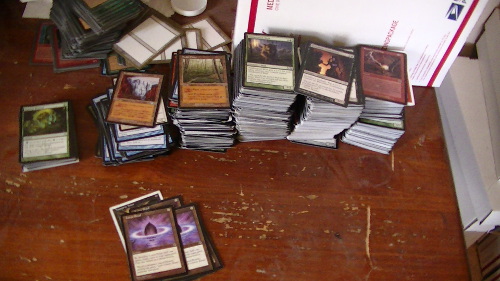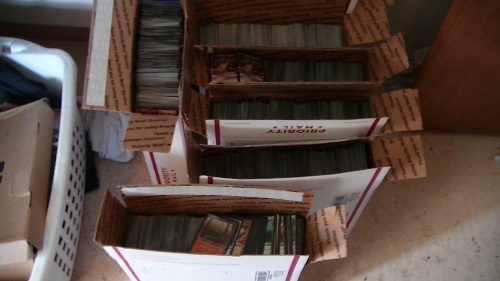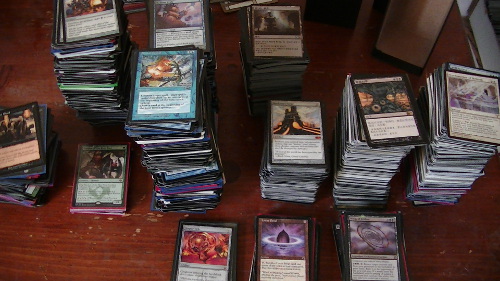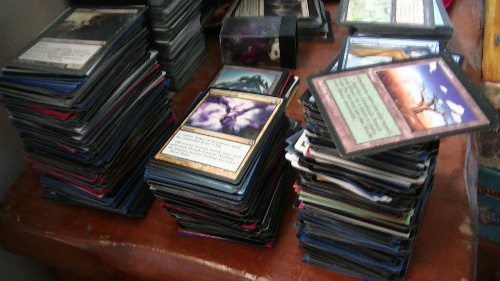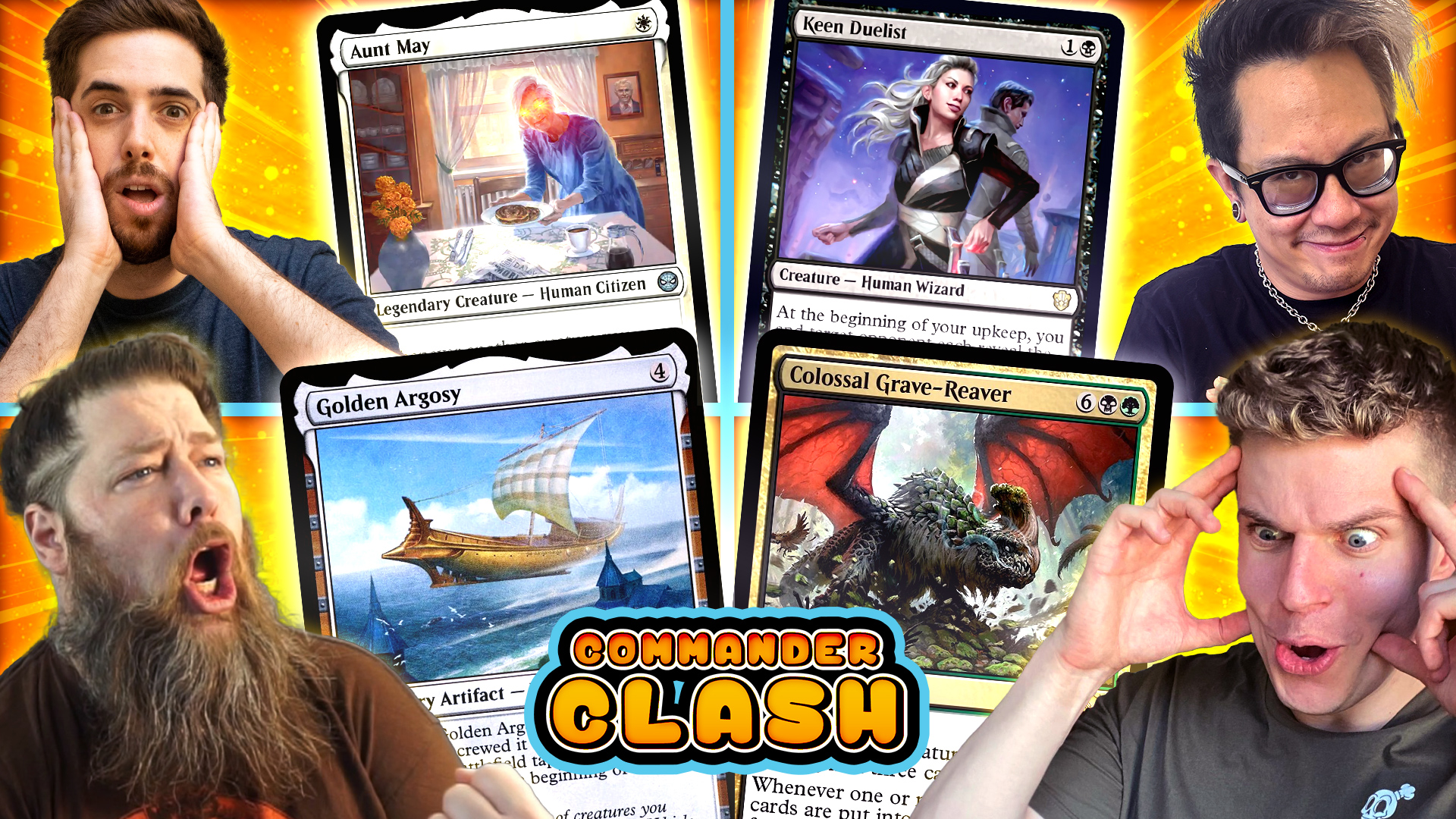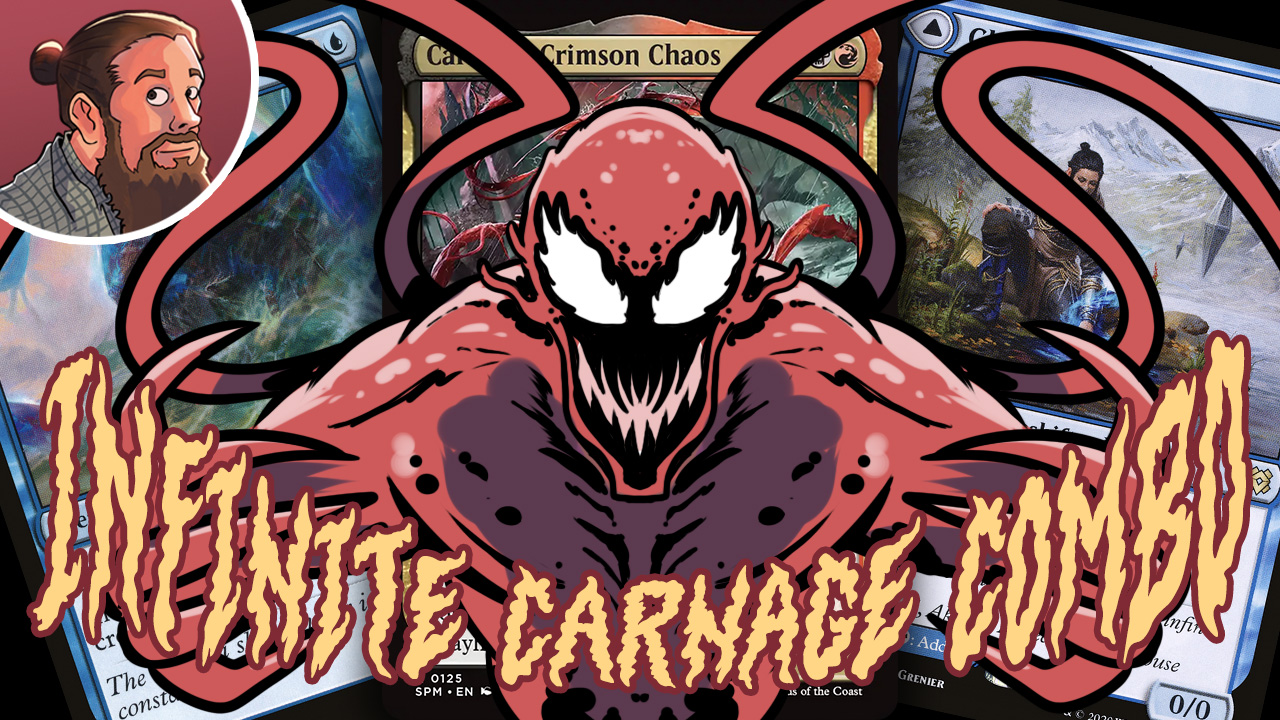Collection Buying 103: Selling a Collection
So a while ago I started a series about collection buying covering where to find and how to analyze collections, along with my rules or process for making it profitable. One question that came up a lot in the comments was "what about selling the cards you buy?" I promised I would finish the series by addressing this topic, but then things like spoiler season, the video series, and real life kept getting in the way. Well, this past weekend I came across a massive collection — 60,000 cards — and I realized that this was my perfect opportunity to finish the series, not just by writing about it, but by actually showing you (with pictures) my step-by-step process to selling the collection.
Friday 9 AM
So Friday morning I'm browsing my local Craigslist and come the above post. I quickly run through the math: 60,000 cards at $5/per thousand equals $300. If we assume the ratio really is similar to that of a booster pack, that would gives us approximately 4,000 rares at $0.10/each which equals $400. Money cards aside, I feel fairly comfortable that I can bulk this out for around $1000 over time. Paying $700 would be ideal, but assuming everything looks legit, paying $1000 isn't out of the question. I text the seller, he responds, we set up a meeting time of noon Friday. The drive for me is about one hour.
Friday 12 PM
No picture for this one because my big beard and massive frame is intimidating enough to people that don't know me. I once had the seller of a $3,000 collection walk right by me at a public meeting outside a Panara Bread only to turn back around, shake my hand and say "I thought about it, what are you going to do? Hit me over the head an try to run away with 20,000 Magic cards?" Asking for a picture would have just added another variable — one that wasn't really necessary — to the process.
Either way, in this case the seller was cool. My "pay $700" plan doesn't work. He won't take less than $1000. I buy the collection anyway, load a ton of fatpack boxes and a stack of two and five row boxes into my car. I almost run into a motorcycle on I-81 driving home; it was in my blind spot.
Friday 2 PM
I finally get everything into the house. While the picture doesn't really capture the enormity of the collection, it at least gives a small taste. Next on the agenda is sorting; this part of the process is going to take a while.
My method for sorting is a bit unique. I know people that will sort all 60,000 cards by set and color, but this is too much work for me. I don't have the time, patience, or outlet to get retail prices for the 20 Chimney Imps I'll find in the collection. My technique is to go through the collection and pull out three things: all the rares/mythics in one pile, all the uncommons in another pile, and any common or uncommon that I can sell (or may be able to sell in the future) in another pile. Everything else will be sold as bulk. I also tend to pull things from odd sets (Portal/Starter, Unhinged/Unglued, Coldsnap rerelease cards), tokens, and basic lands, not so much because they are valuable, but because some bulk-buyers don't like getting boxes full of tokens and basic lands.
I tend to pull aggressively. For instance, I remembered that at one time I could buylist Ambush Vipers for $0.05, so I pulled them all. It is way easier to pull too much and dump some cards back into the bulk than to not pull something and have to go back through 60,000 cards. This is one of the weaknesses of not sorting by set and color, but I still don't think it's worth it for me.
I pack the bulk into medium flat rate boxes as I go. Once a card is in a flat rate, it's gone. Never will I look at, touch, or think about it again. I've sure you've heard the much repeated MTG finance mantra "leave the last 10 percent for the next guy" in regards to selling specs. Well, this is also my theory in sorting bulk. I'm very confident in my ability to pull value from a collection, but I'm sure I miss a small numbers of low-value cards. These are the 10 percent for the next guy, which actually works on two levels. First, going through 60,000 cards a second time looking for a handful of $0.10 cards that I missed just isn't a good use of my time. Second, having a few playable/semi-valuable cards in the bulk actually makes the bulk-buyer happy.
By the time I'm done sorting, every single one of the 60,000 cards will either be in one of the piles I just talked about or be declared bulk and put into a flat rate. There is no in-between. For me this process is basically reflex and memory at this point. I don't type a single card into a website until the sorting is done. Instead my laptop is occupied by Netflix as I re-watch the entire series of Black Mirror, or by Youtube where I listen to Jeffery Lewis and early Tom Waits where he sounds like a drunken pirate.
Speaking of Black Mirror, I really think that this is one of the best/most thought provoking/most important shows to come out in recent years. 2000's television for me really boils down to two shows: Arrested Development, which is basically the perfect sitcom (if you even want to call it that) and Breaking Bad, which I started watching with the first episode and it grew into perhaps the best television show ever made. While Black Mirror only has eight episodes and can be inconsistent at times, at its best, I think it deserves to be mentioned in the same breath as the other two.
Friday 7 PM
I finally call it a day; there is more to life than Magic cards after all. I've made it through a quarter of the collection. So far things are looking fine but not super exciting. Rather than being an easy home run where you can sell of a handful of money cards to break even, this one looks like a grind for value.
Saturday 8 AM
I spend all day Saturday sorting the rest of the cards. I take a short break in the afternoon to catch my little brothers AAU basketball game, which happens to be attended by Syracuse basketball coach Jim Boehiem because his son is playing in the tournament. One of my brother's teammates thinks its funny to ask Boehiem how many wins he has, to which he replies "I don't recall, since they just took half of them away" before walking away abruptly. Ouch.
Saturday 6 PM
I finally finish sorting, but not before running out of flat rate boxes. I have seven fully loaded with commons and the cards to fill another four or five. The coverage of GP Toronto makes the day bearable. I think about starting on the singles, but I decide against it. Most buylists update at midnight anyway, so getting a quote on Saturday night doesn't guarantee that it will still be good on Sunday morning. On top of the bulk, I end up with maybe 4,000 cards I plan on moving individually, either to buylists, on eBay, or in trade. This group includes everything from Vampiric Tutor, fetches and shocks, to Llanowar Elves and Lightning Bolts. This will be the project for Sunday.
Sunday 7 AM
So this is what I start off with on Sunday morning: piles of uncommons and commons that I think I can sell, piles of rares and mythics, and a pile of foils topped by the Japanese Radiant Fountain (which strangely enough, is actually worth a few dollars). I quickly do one more sort, this time breaking down each group (rares, c/u, and foils) by color. After I finish this sorting, it's time to start working through the buylists.
I sell a decent amount of the cards I buy in collections to buylists. I've researched it a few times and often the best buylist price isn't much lower (or any) than selling on eBay when you take into account the fees, shipping, and effort it requires to lists cards. This, of course, isn't true for all cards. If I don't like the spread offered by the buylists, I just hold onto the cards to either sell or trade away later.
Another underestimated aspect of collection buying is the ability to acquire specs. As I'm selling the collection, I pull out cards I want to save for the future and stick them aside. There is basically no cost to pulling out bulk rares with upside and sitting on them for a while. Odds are you'll be able to move them for the same price down the road if they don't pan out.
Sunday 8 AM
Part of the trick to buylisting is you need to sell to multiple vendors to get the best price, but also not too many vendors because this can lead to inefficient shipping. To complete this process you really have two options: The first is to type each cards into multiple buylists, see what each is offering, and then sell to the highest bidder. Unfortunately this is a very slow and painful process. With several thousands cards, typing each name three, four, or five times is just too time consuming to be profitable.
The other option is to use a site which keeps track of multiple buylists. At the moment this means using either the QuietSpeculation trader tools or MTGPrice (as an aside, MTGGoldfish has recently started adding buylist prices, and hopefully more will come in the future). From my perspective, trader tools are currently the best on the market, but you also need to pay a monthly fee to gain access. MTGPrice offers both a free and paid version, and while the free versions isn't as in-depth, it is usually good enough if you don't buylist all that often.
As far as the buylist I use, I have full confidence in CardKingdom, StarCityGames, ChannelFireball and ABU. I also recently started using CCGHouse, which seems fine so far. I used to use Troll&Toad regularly, but lately there have been some negative rumblings in the Twitterverse. I decided to send them a small order as an experiment to see how things go. I do not use Strikezone for selling cards from collections. Even though they often have the highest offer, the are also incredibly strict about grading (sometimes illogically so) and ship back rejected cards (sometimes entire orders) at the seller's cost. I have also been waiting a year to get paid for some bulk cards sold to MTGFanatic, so they are off my personal list as well.
I wish I had some great words of wisdom about this process, but it is literally a grind. You type a card, find out who is paying the most, and stick it in the correct pile. Type the card, find out who is paying the most, and stick it in the correct pile. You repeat this for hours, hopefully with some good music or coverage on the TV. This was basically my entire Sunday. Type, pile, repeat, type, pile, repeat. I finally finished going through the singles at about four in the afternoon.
To be fair, I did cheat at one point and submit an order early. I always check Troll and Toad's bulk buylist because sometimes they are buying random things for very good prices — for instance any foil mythic for $1.05 or any non-foil mythic for $0.60. The bulk deal of the day was uncommons for $18.00 per thousand — almost $0.02 each. When I started buylisting they were asking for 57,000. When I checked a couple hours later it was all the way down to 7,000 (Troll and Toad updates their buylist every 15 minutes, which is actually sort of annoying). I quickly entered 4,500 (the approximate number I could fit in a Medium Flat Rate along with the rest of the buylist) and submitted my order. I then immediately started a second buylist.
Sunday 4 PM
I've learned one very important thing about buylists over the years: Just because you put a card on the buylist and submit the order does not mean you have to send it. Buylisting is a tentative process. The vendor offers a price, but it is conditional on their very subjective grading process. Some vendors will actually ship back the cards that don't meet their criteria. There is no 100 percent guarantee here.
Now I'm not suggesting that you should submit false buylist orders — please don't. I ship a huge percentage of the cards I submit. However, the next step in the buylisting process is to sort each individual order alphabetically and by set. If you don't, the vendors will charge a significant shipping fee.
As I go though this process order by order, I do pull cards out on occasion. Sometimes to keep for my personal use (at one point I built a cube by pulling one card from each buylist order I sent), or because I realize I can get more for it somewhere else. I'll often leave Pucatrade up while I'm doing this final sort, and if I run across a card that will trade for significantly more than I'm buylisting it for, I pull it out an ship it through Pucatrade. While I could do this while I'm creating the buylists, having another window to manage, another site to type into, and another pile to keep track of just isn't worth it for me.
Plus, in this case, I really, really, really wanted to get my buylist submitted before Modern Masters 2015 spoilers started. While I didn't expect many of the high-end card to be impacted, I did have a bunch of semi-valuable commons and uncommons (things like Cranial Plating) that could potentially pop up in the set. Even though I haven't shipped the order yet (that will be tomorrow), by getting the order submitted to a reputable vendor I have my price locked in.
Sunday 5 PM
This is my buylist order to ABU, sorted (roughly) by block and ready to be ordered alphabetically and by set. The best thing about ABU is that they are always buying foreign commons and uncommons for significantly above-bulk prices. It doesn't even matter how bad the cards happen to be; if they are from a relatively recent set, they'll buy them for a minimum of $0.04 for commons and $0.06 for uncommons. Easy money.
Along with the foreign cards, I also sold ABU a decent amount of foil basic lands for between $0.30 and $1.00 each, and piles of seemingly bulk rares that they valued at $0.19, which is basically the cut off for me. If a bulk rare will not buylist for at least this amount, it generally ends up in the bulk lot pile which is used to sweeten the deal for the people who will buy my 60,000 commons and uncommons.
Total ABU: $224.03 (since ABU allows you to grade as you go, this should be very close to the final total).
Sunday 6 PM
Every time I go on a buylisting spree, it seems like Card Kingdom ends up being the biggest order. The tend to pay the best for $1 to $5 cards of all rarities and are generally just a pleasure to deal with. This collection is no different — by far the largest pile I'm shipping out is heading to Card Kingdom. It ranges from random bulk commons sold for $0.05 each (presumably because CardKingdom has a low supply) to some shocks and fetches in the $10 range.
The only downside to Card Kingdom is that they don't buy some odd cards; no foils (apart from promos or dual decks) and no foreign cards. This really isn't a big deal assuming you are selling to multiple vendors. Shopping around is extremely important; there are always some cards that one vendor is paying bulk rates for while another is offering $1 or more. This is mostly an issue of supply. If a vendor has many copies of a card, they often drop their price below market value. For instance, say Card Kingdom has 100 Jace, the Mind Sculptors. "Market rate" for buylists is generally around $65. Card Kingdom doesn't want any more Jaces at the moment, so what do they do? The drop their buy price to $45 dollars. If people keep selling at the new price, that's fine because they are getting an extremely popular card for dirt cheap. If people stop selling, that's fine too. It's basically a win-win for the vendor. Of course, once they work their way through the backlog of supply, they will up their buy price again.
CardKingdom Total: $316 (I shipped most of the played cards to other vendors, so I expect this number to be fairly solid as well).
Sunday 7 PM - How I Package Cards for Shipping
Start with a stack of around 100 cards and a piece of copy paper. Scrap paper is fine.
Fold the long side of the paper up under the stack of cards.
Fold in the sides around the stack of cards.
Fold over the last small side of the paper around the flaps, creating a tight paper cube of cards. Stick a piece of tape on the back (open) side for extra security. Write your name, address, order number, and any other important information on the front.
I've used this method for shipping large lots of cards for years and never had a problem. Sending 5,000 cards (as I am to Troll and Toad) basically necessitates a flat rate box. There is just no other way to do it efficiently. As such, using actual card boxes isn't really an option. I do not do this for bulk cards (for instance, the 4,500 uncommons). These are simply packed length ways into the medium flat rate (which is very close to the same size and shape as a 1,000 count long box.)
Troll and Toad Total: $151.61 (I have no idea what to expect after grading. This buylist is for the great deal on bulk uncommons and is also an experiment).
ChannelFireball Total: $165.16 (I expect a slight grading deduction, maybe into the $140 range).
CCGHouse Total: $78.68 (Shouldn't be any major grading issues here).
Singles Total: $940
Grading Deduction: -$25 (I should note that this is lower than usual, but this is a result of the collection being in extremely good shape).
Shipping Costs: -$40 (All flat rates of various sizes).
Grand Total (for singles): $875
I realize this doesn't seem all that exciting, and honestly it isn't. It would much rather than that "grand total" be $1200 or more. This said, it isn't all bad news, because there is one saving grace to this collection: we still have 60,000+ cards to sell.
The Bulk
This is the final step of moving the collection. Currently, I have 60,000 bulk commons and uncommons, maybe 500 bulk foils, and 1,000 bulk rares. Ideally I'll be able to sell these locally. If someone wanted to take all the bulk commons off my hands for $400 I would let them, but the more likely scenario is to piece out "instant collections" either locally or on Ebay.
There are a couple options here. Some people have lots of luck selling 1,000 card sets, mostly commons and uncommons, with maybe 20 rares and a few foils for about $12 per when you consider all the fees. This route will take a while, but offer the best outcome, adding up to an additional $720 in profit. The second option is to sell 5,000 card lots with 50 rares, some foils,, and maybe a deck box or package of sleeves. Online, the profit here is between $35 and $40 per lot, adding somewhere between $400 and $500 to the value of the collection.
Of course, every one of these I can move locally adds a significant amount to the profit, maybe $20 per 5,000 lot and $5 per small lot. Shipping and fees are certainly a killer in this instance, as are the constant packing and trips to the post office. It is generally worthwhile to sell for less to a local just to avoid the fees and hassle of selling bulk online.
Either way, I'm shooting for about $600 from the rest of the cards, which pushes the entire collection into the $1500 range, not to mention a couple hundred cards I kept out for long-term specs (a bunch of Commander rares and some other stuff). These cards aren't super valuable, but given the choice between bulking them out now and setting them aside for a while to see if they grow, the second option is preferable. Overall, the collection is not a home run (mostly because of the amount of work) but reasonable for three days of working at home while watching Netflix or GP Coverage.
Conclusion
Anyway, that's all for today. Make sure to leave any questions in the comments. I tried to cover pretty much everything, but if I missed something make sure to ask and I'll do my best to answer. As always, you can find me on Twitter (or MTGO) @SaffronOlive.



